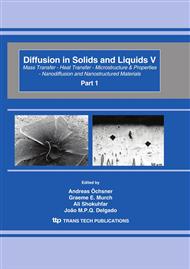p.1340
p.1346
p.1354
p.1362
p.1371
p.1377
p.1389
p.1395
p.1400
Composition and Pressure Dependence of the Diffusion Coefficients in Binary Liquid Alloys
Abstract:
There are a number of well-known empirical relations for diffusion in solids. For example the proportionality between the self-diffusion activation energy and melting point or between the entropy of the diffusion and the ratio of activation energy and the melting point (Zener rule) are perhaps the best known ‘rules of thumb’. We have shown earlier in our Laboratory, that these relations are direct consequences of the similarity of interatomic potentials seen by ions in solids. On the basis of this, similar relations were extended for impurity and self diffusion in binary solid alloys. In this paper, results for binary liquid mixtures will be reviewed. First a minimum derivation of the temperature dependence of the self-diffusion coefficient, D, is presented (minimum derivation in the sense that it states only that the reduced (dimensionless) D should be a universal function of the reduced temperature), using the similarity of interatomic potentials and dimensional analysis. Then the extension of this relation for determination of the pressure and composition dependence of the self-diffusion coefficients is described using pressure and composition dependent scaling parameters (melting point, atomic volume and mass). The obtained universal form (valid for binary liquid alloys) is very useful for the estimation of the temperature, composition and pressure dependence of the self-diffusion coefficients. Finally, the relation for the ratio of the impurity and self-diffusion coefficients is derived.
Info:
Periodical:
Pages:
1371-1376
Citation:
Online since:
April 2010
Authors:
Price:
Сopyright:
© 2010 Trans Tech Publications Ltd. All Rights Reserved
Share:
Citation:


